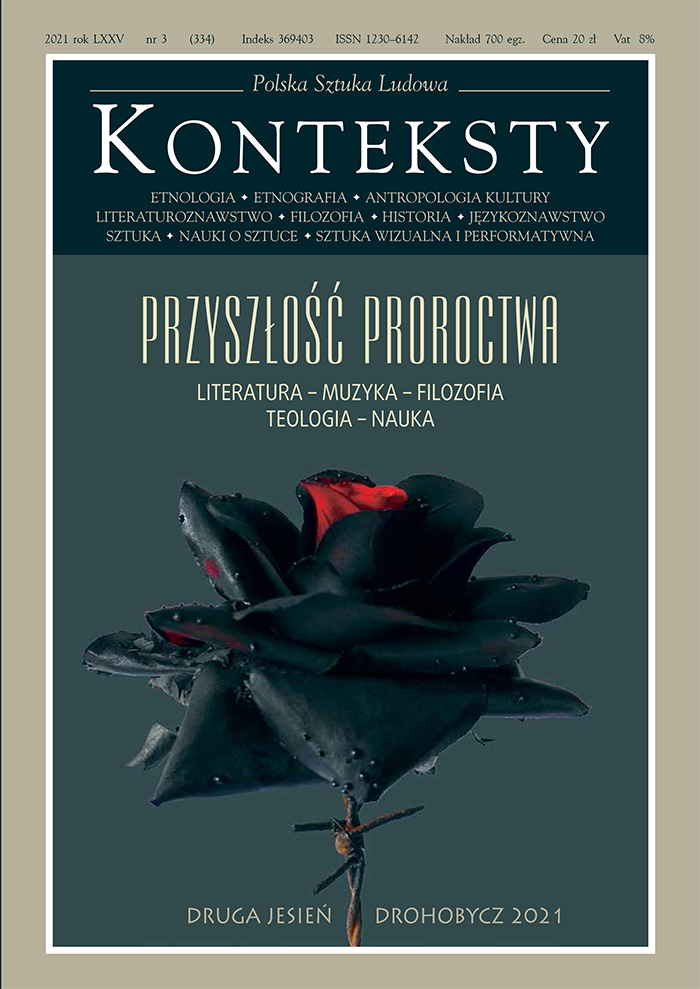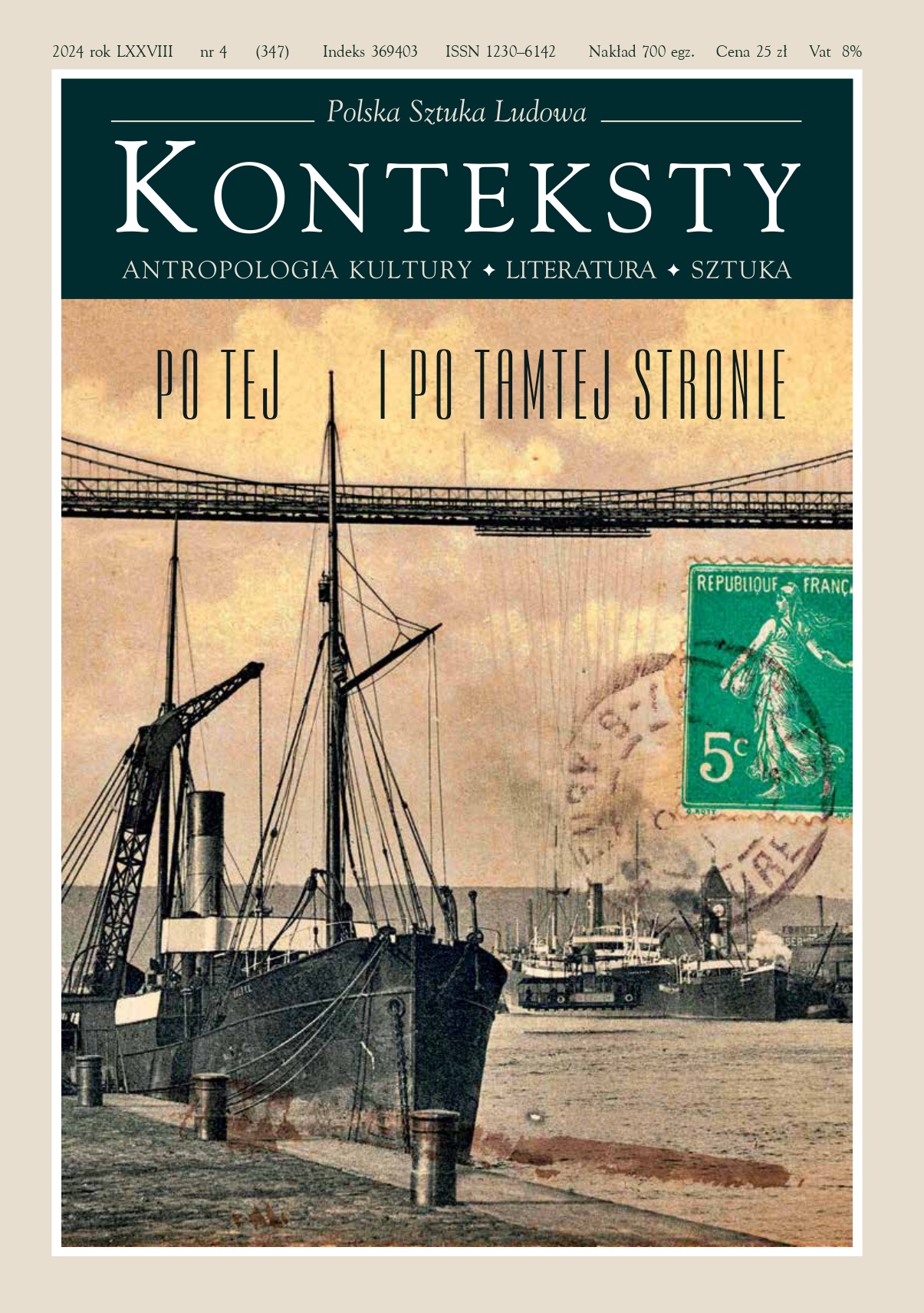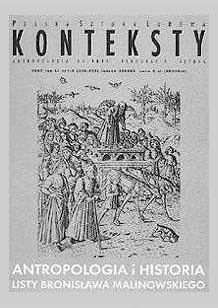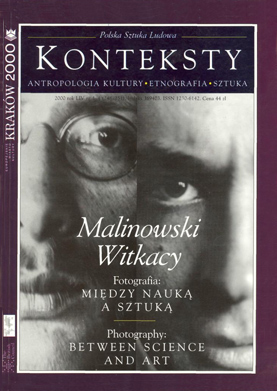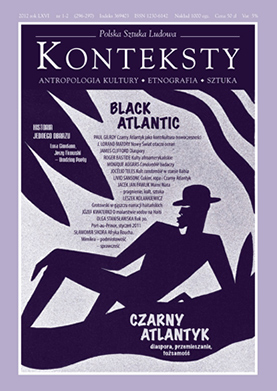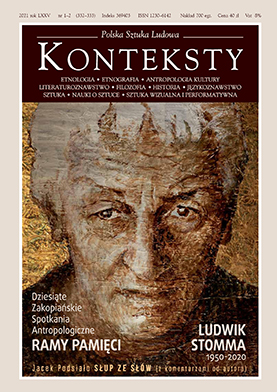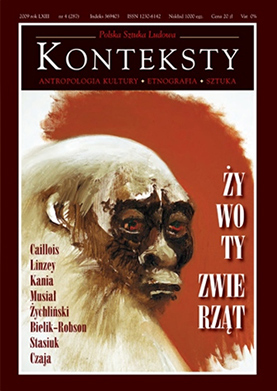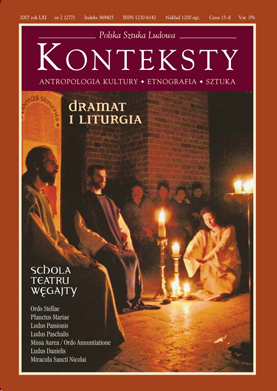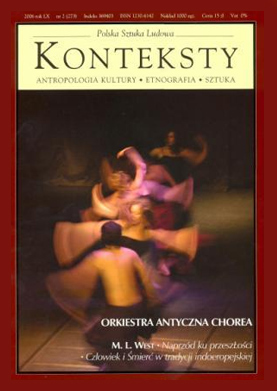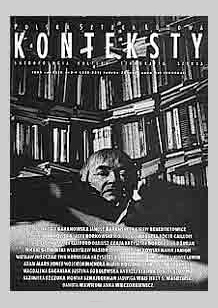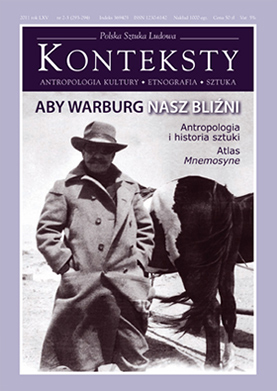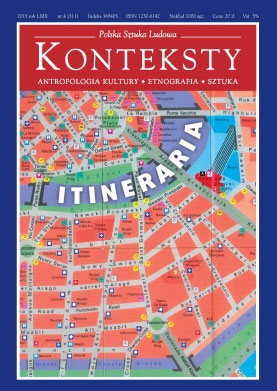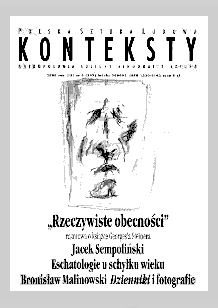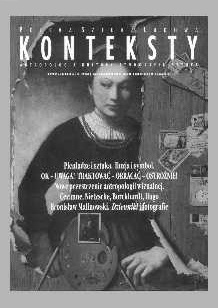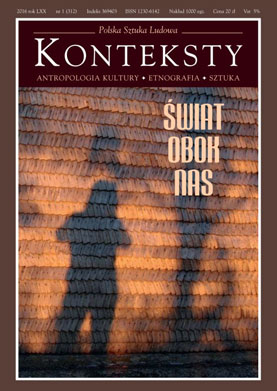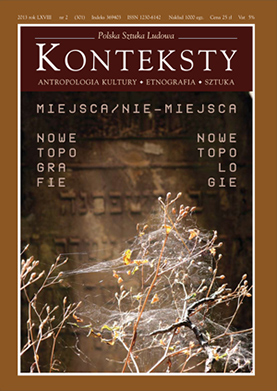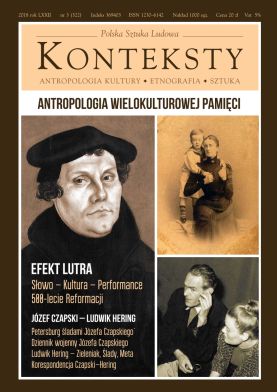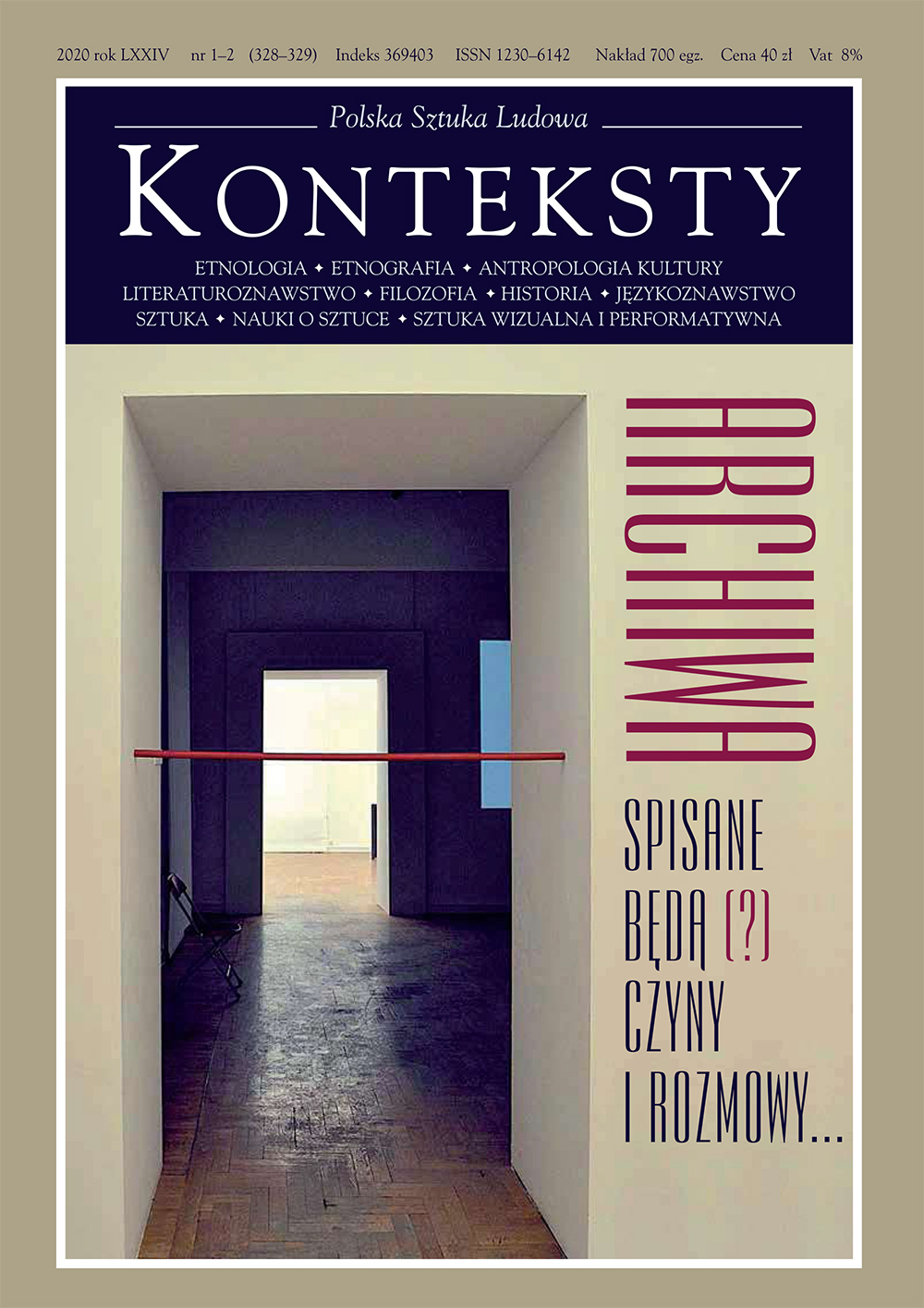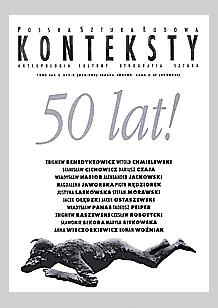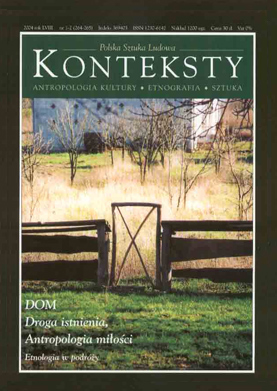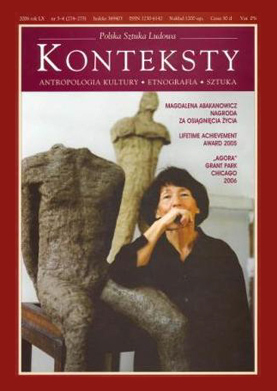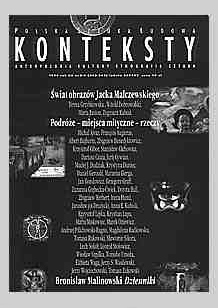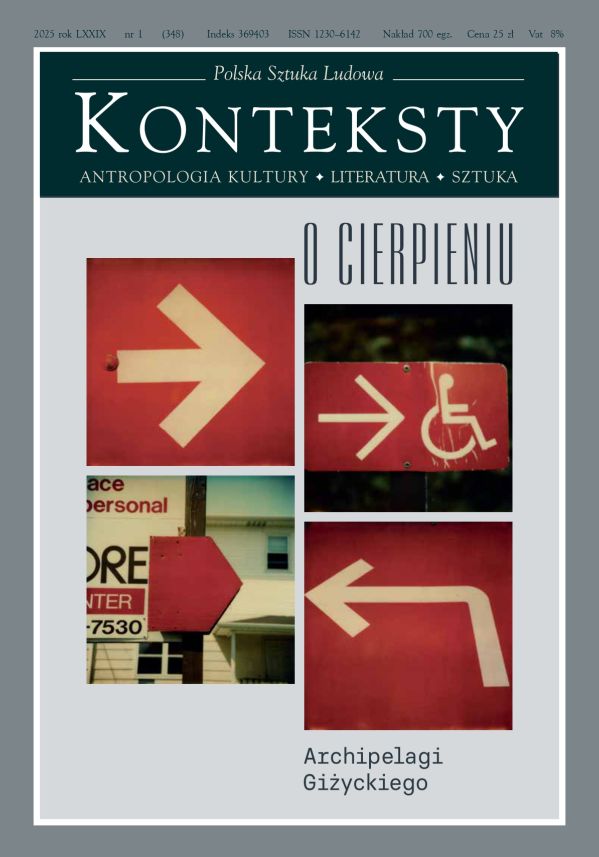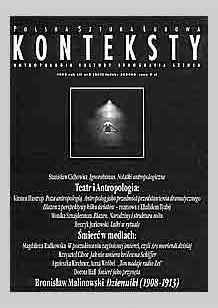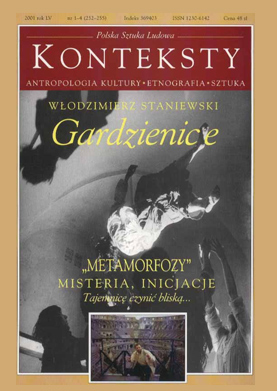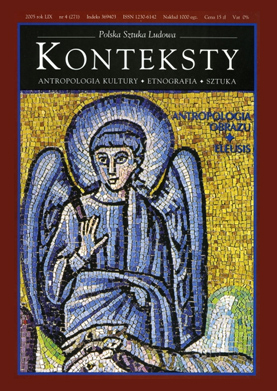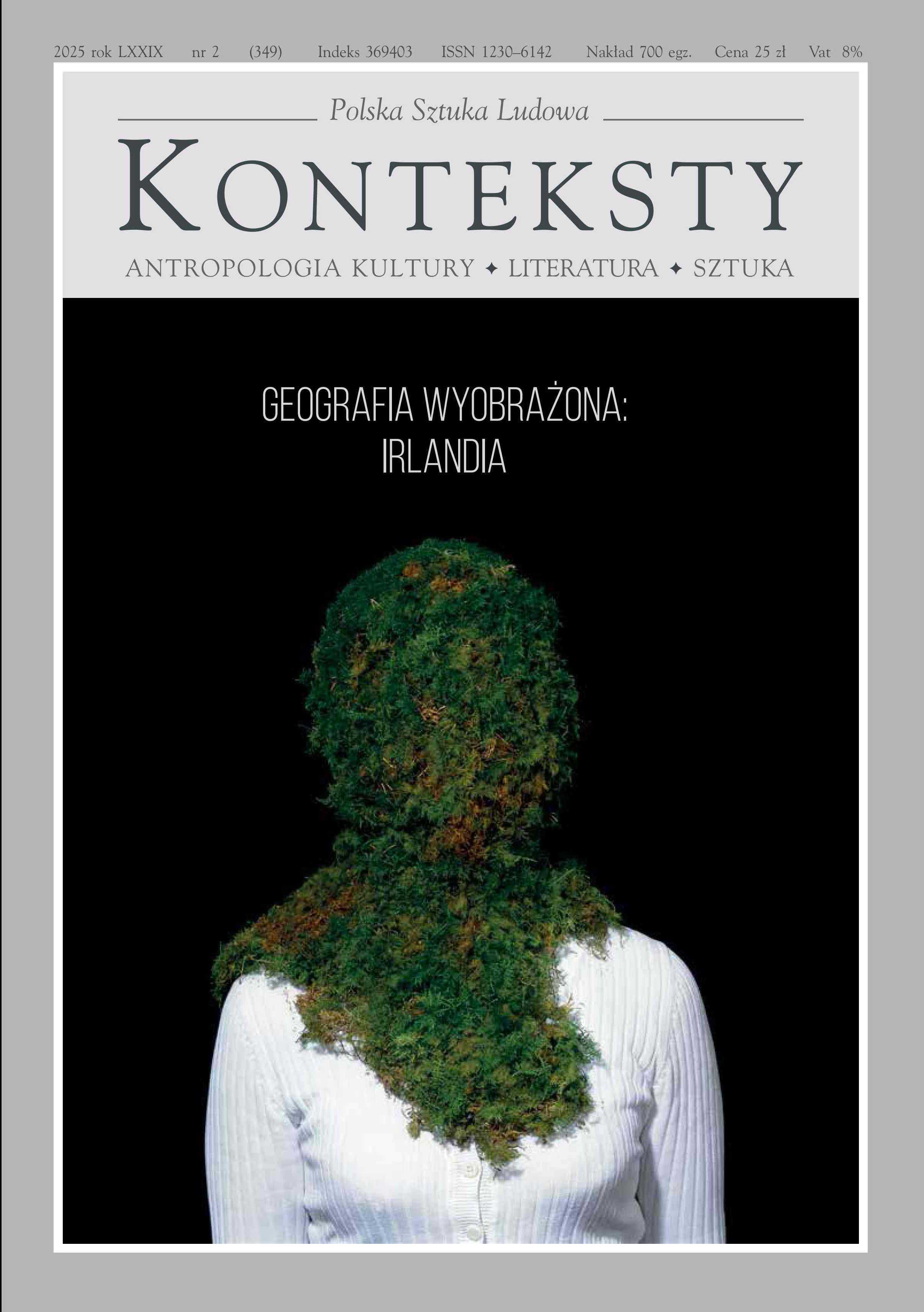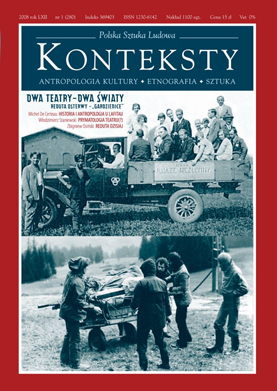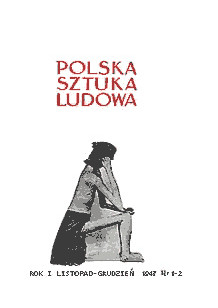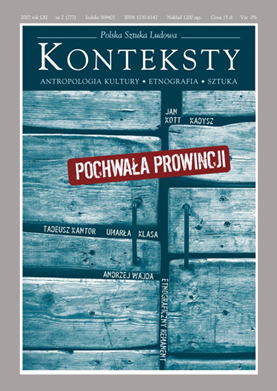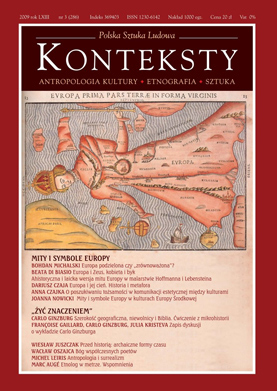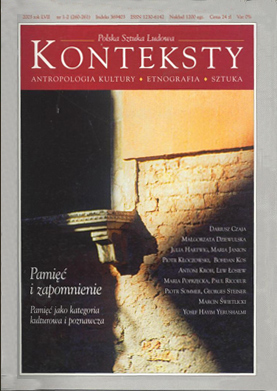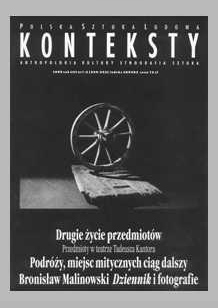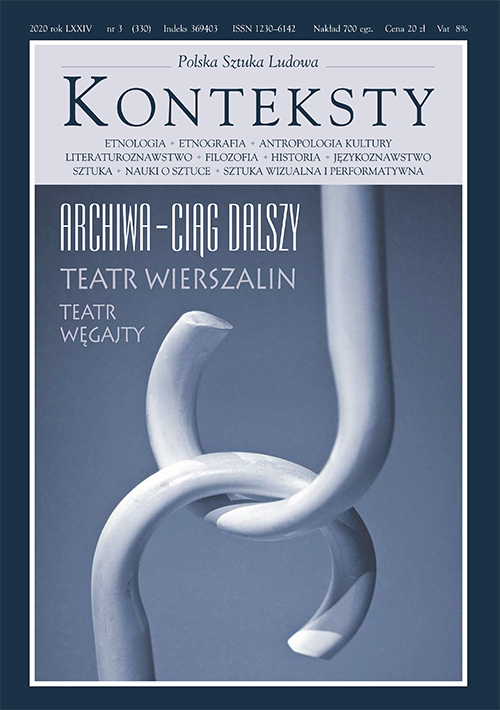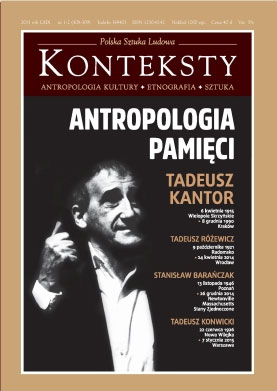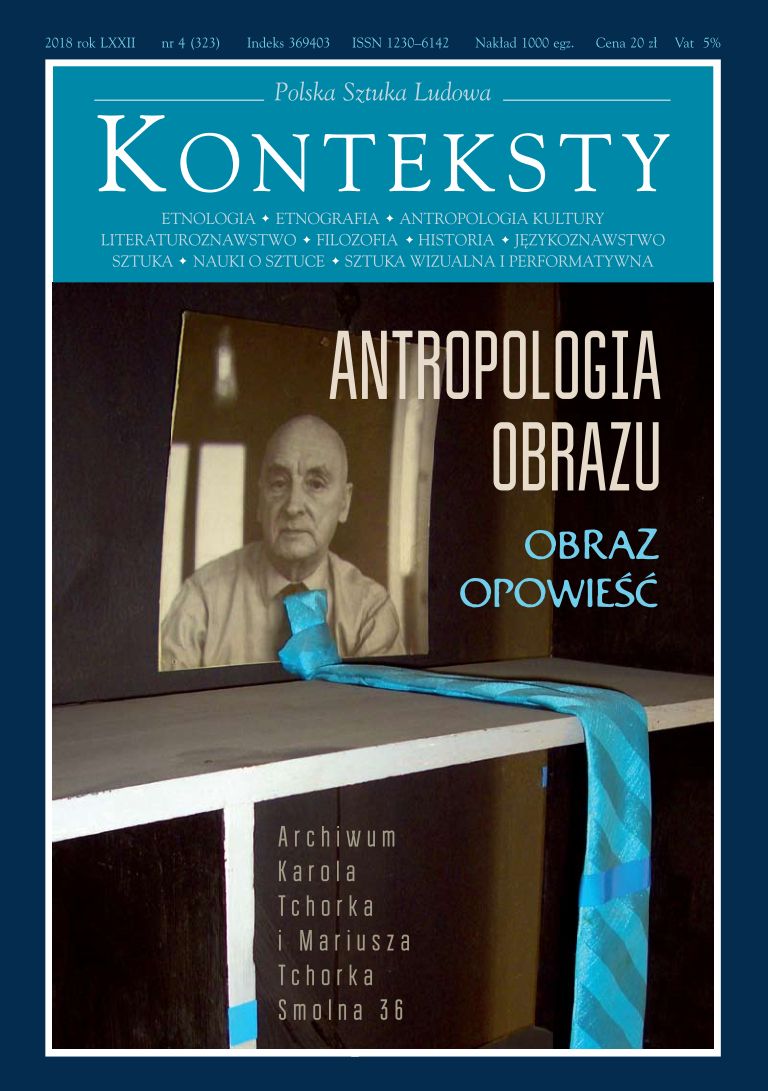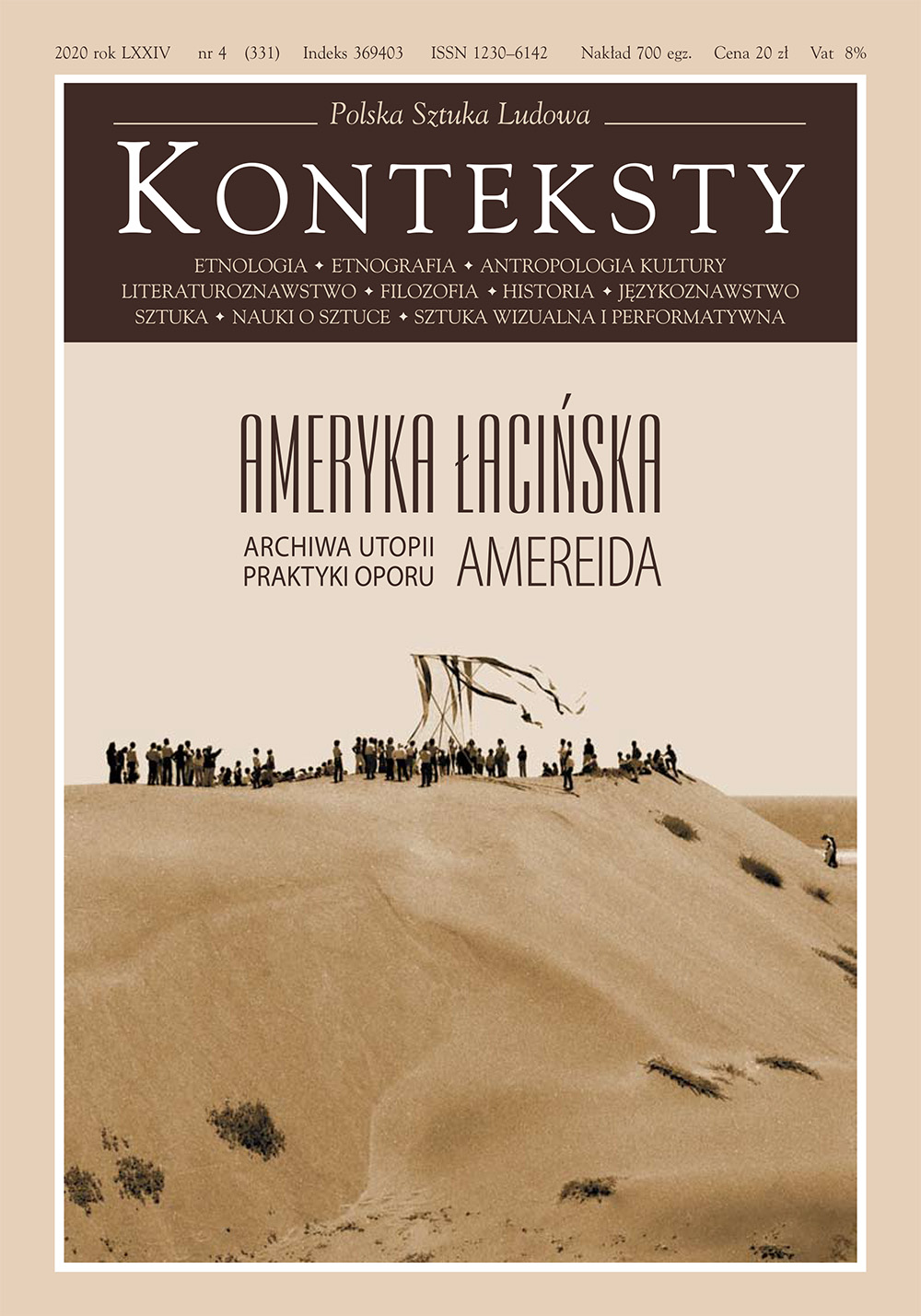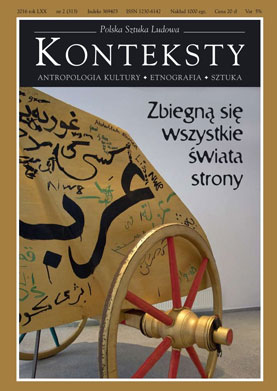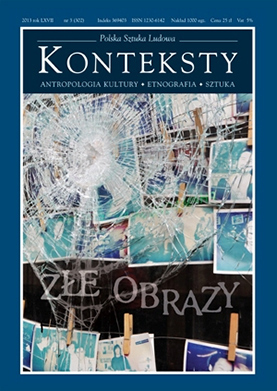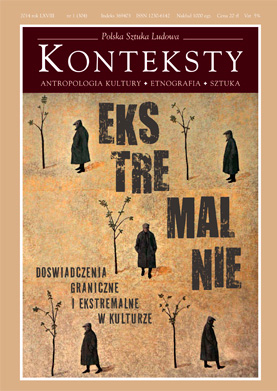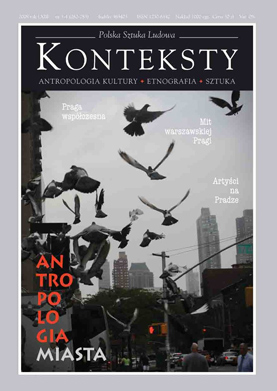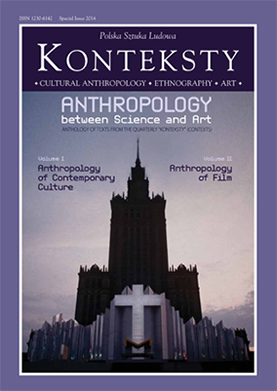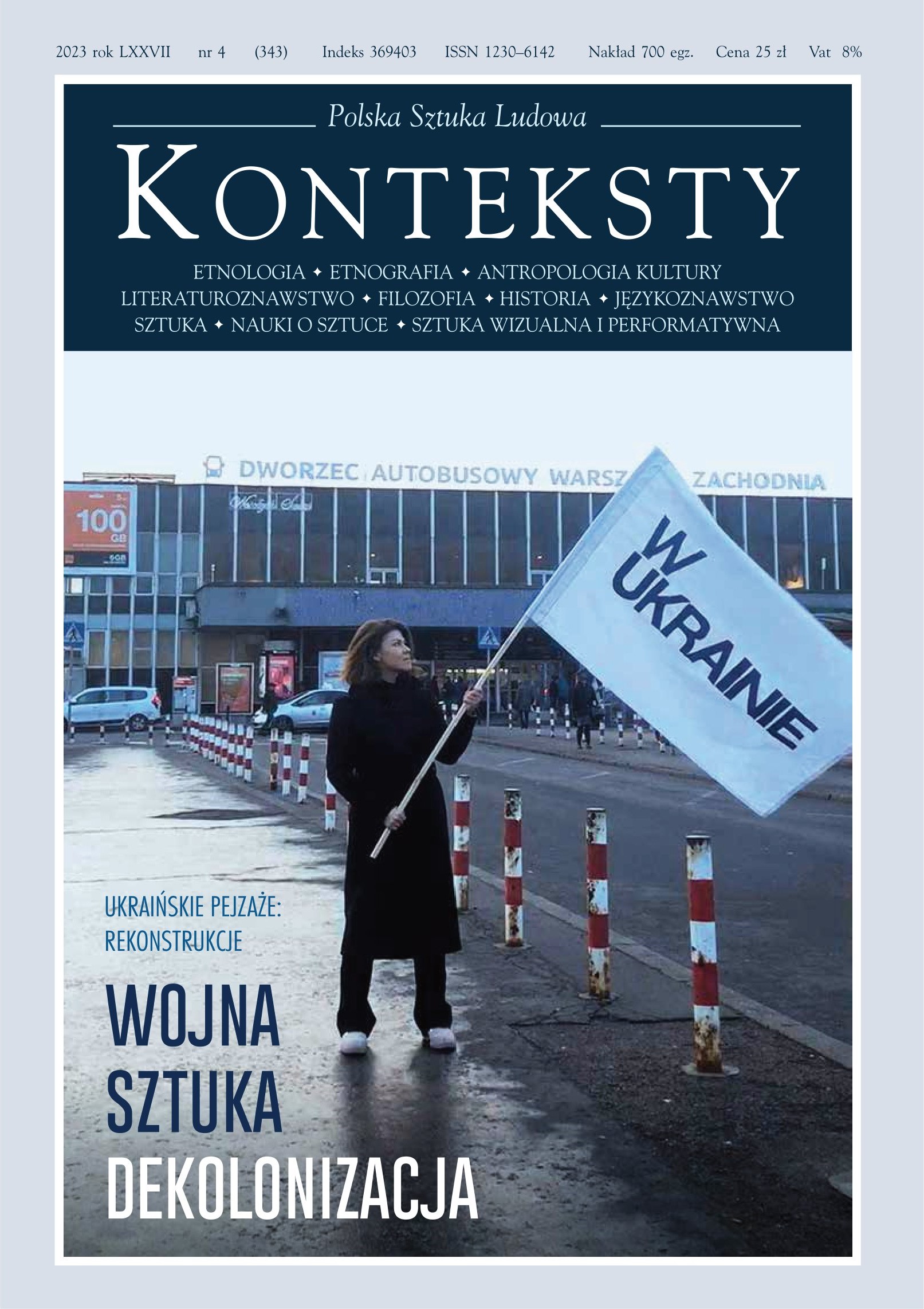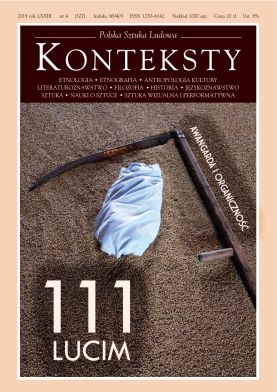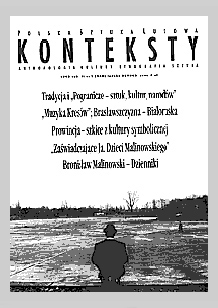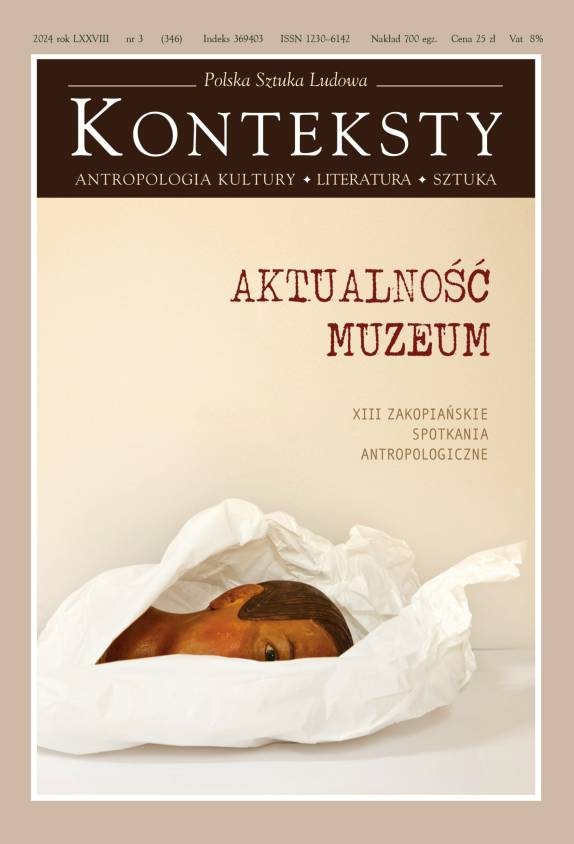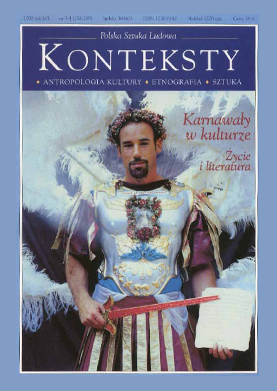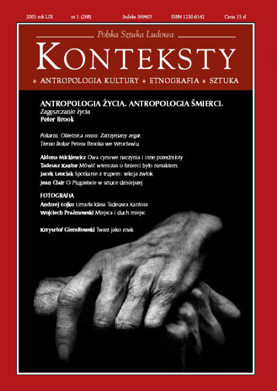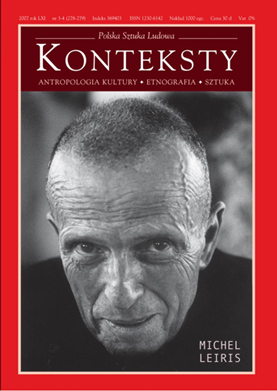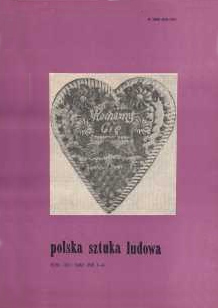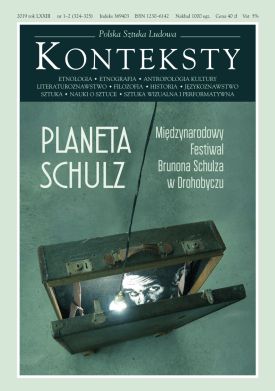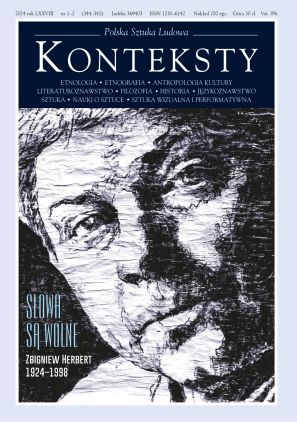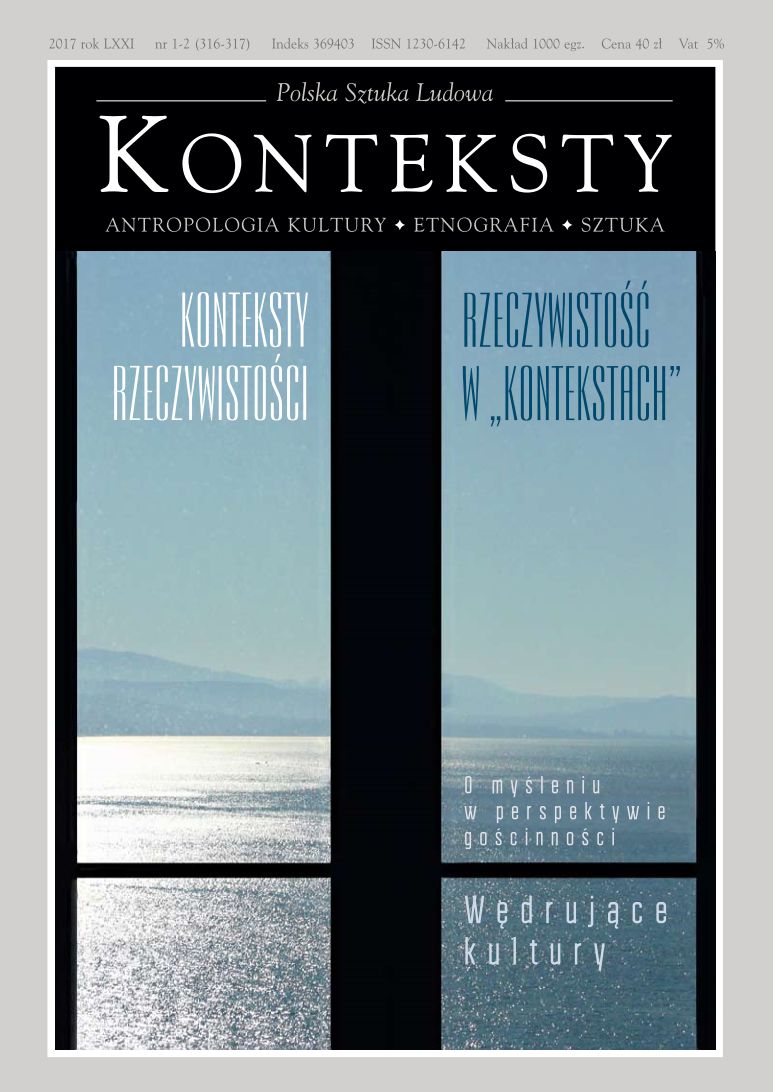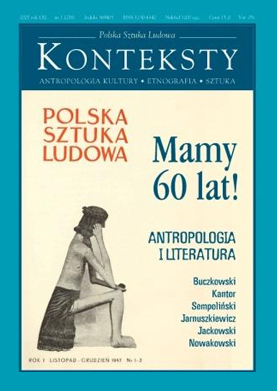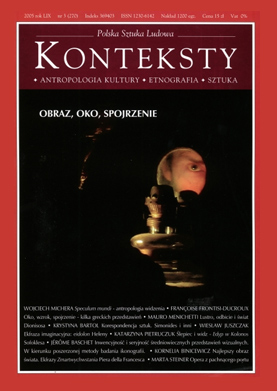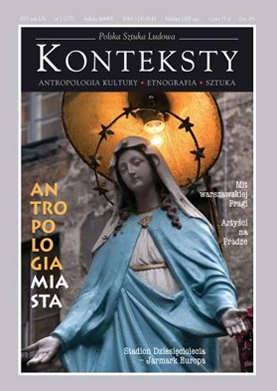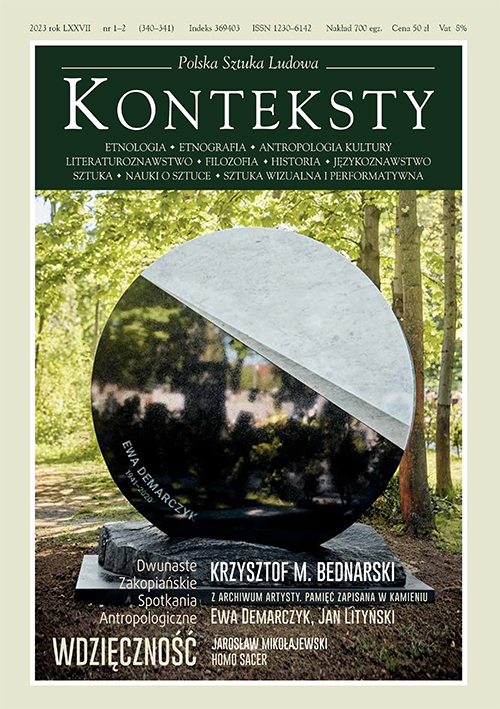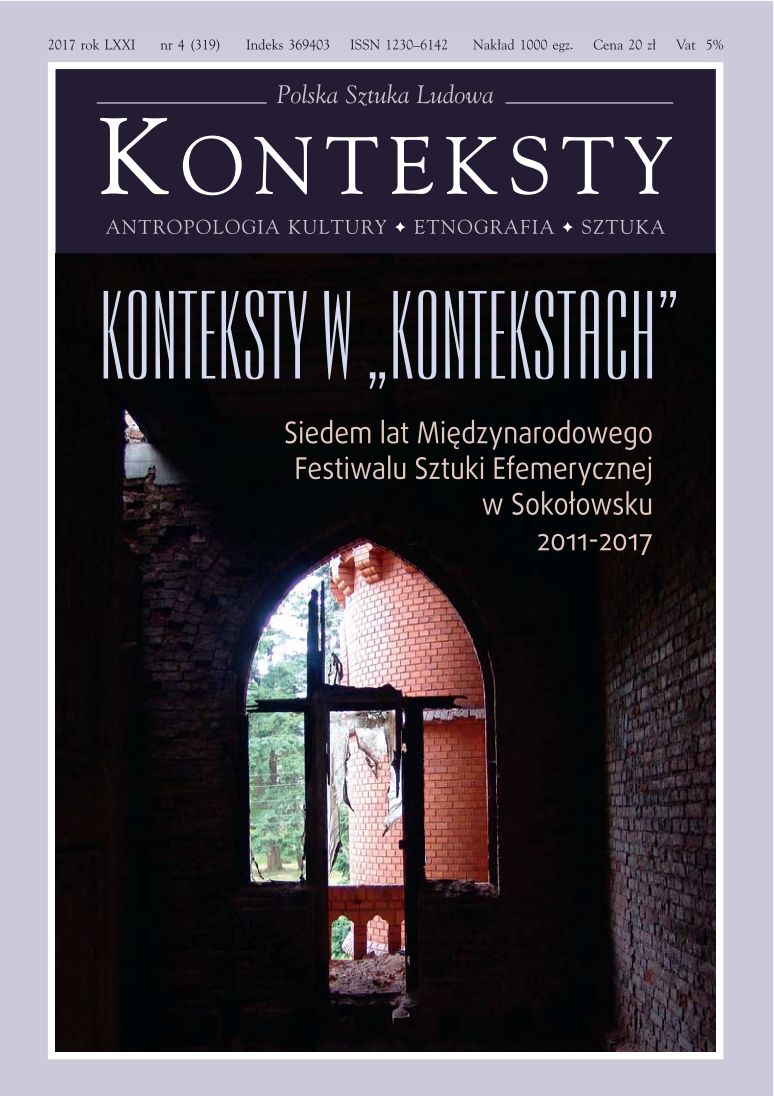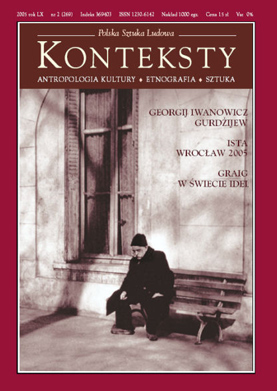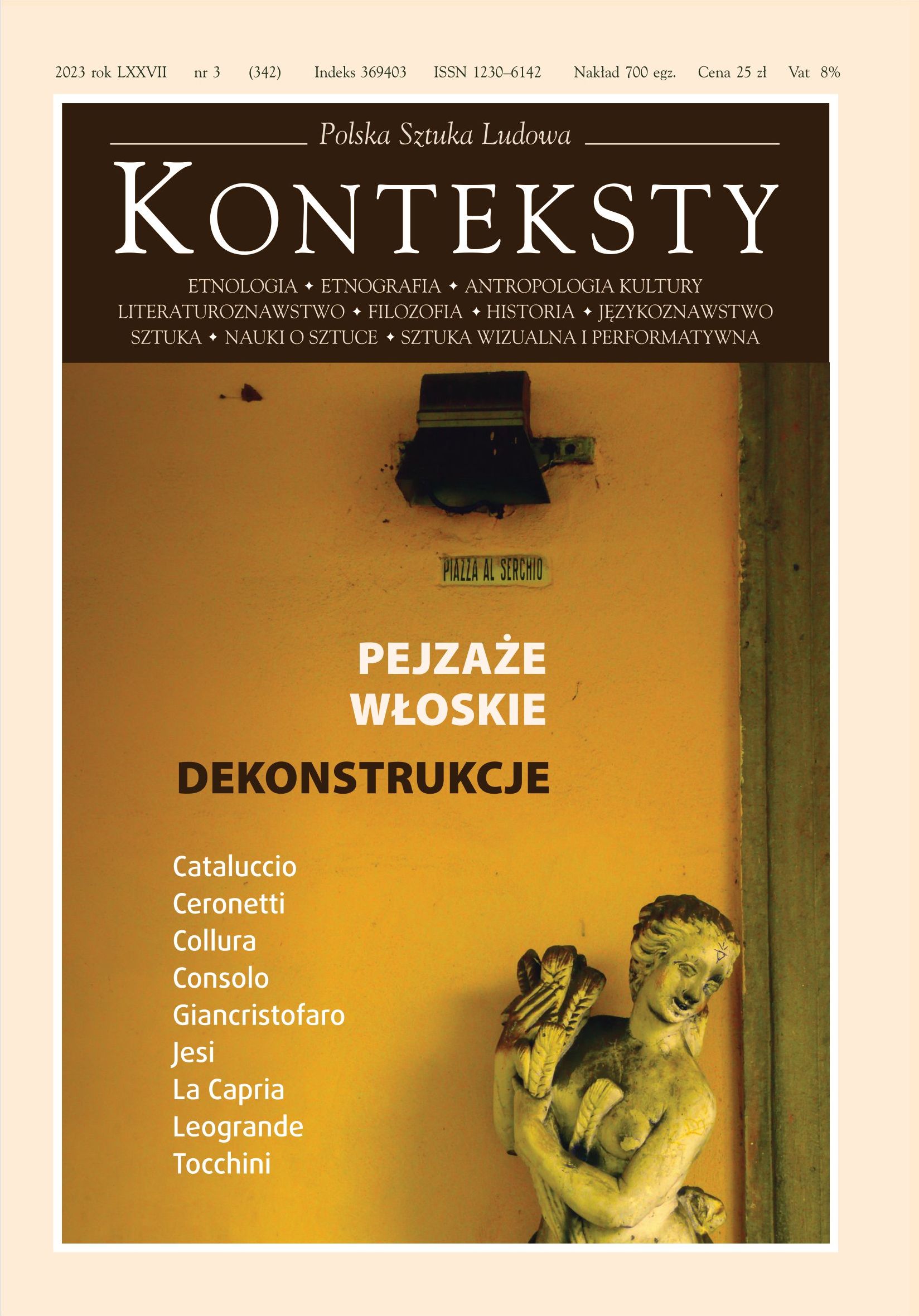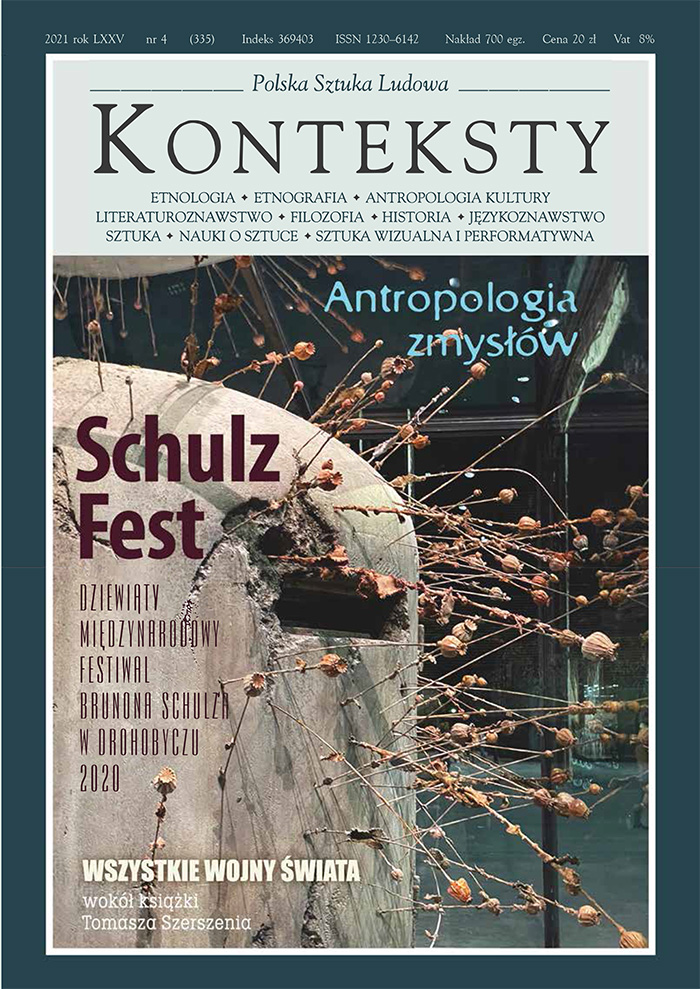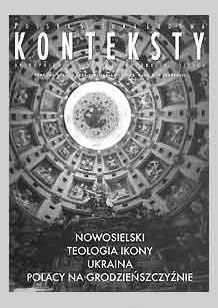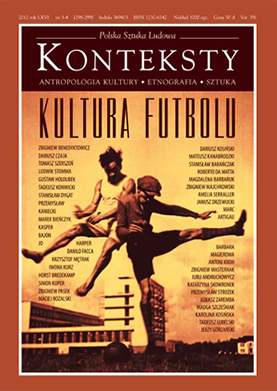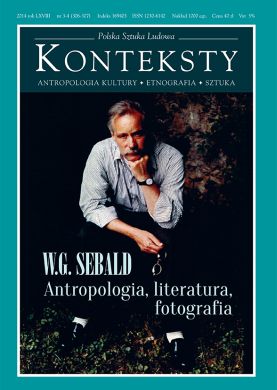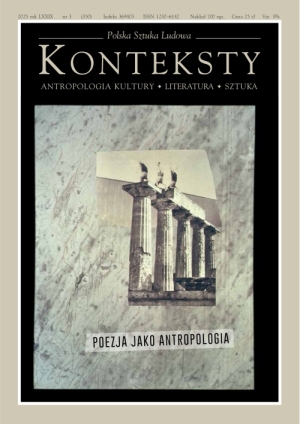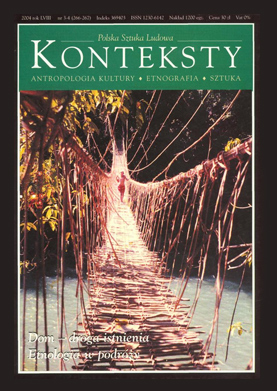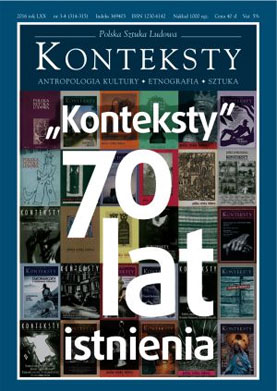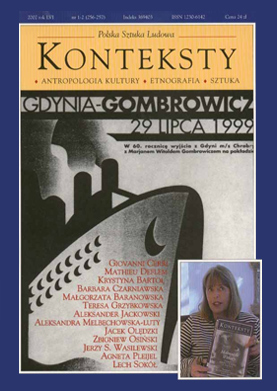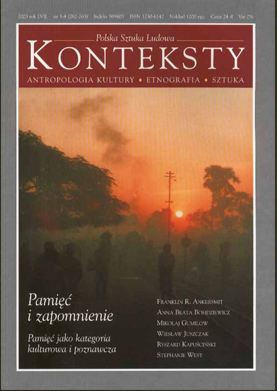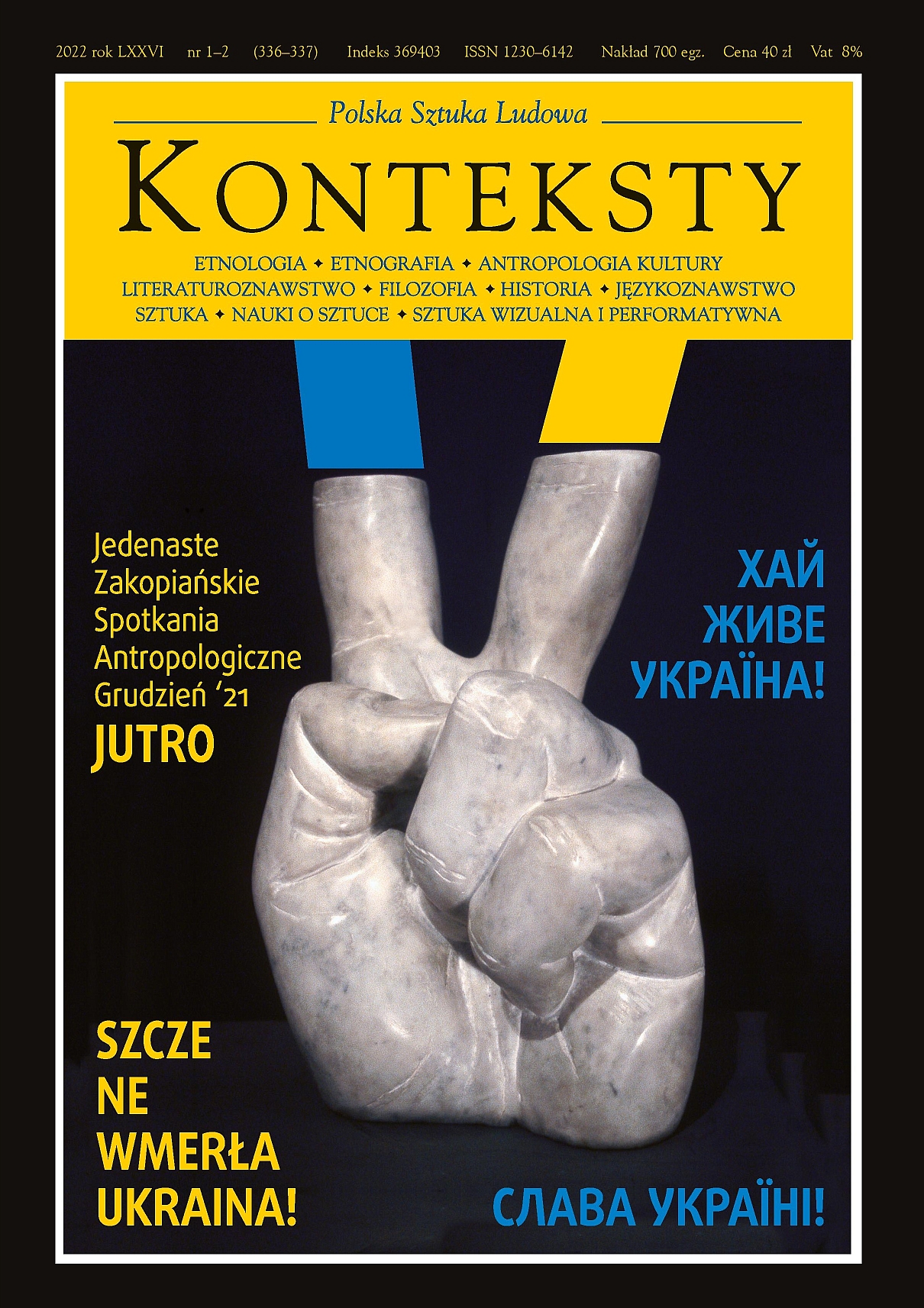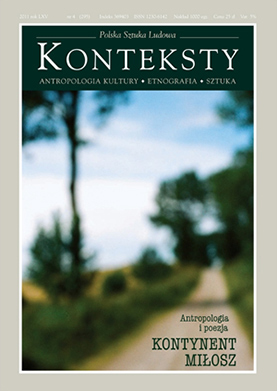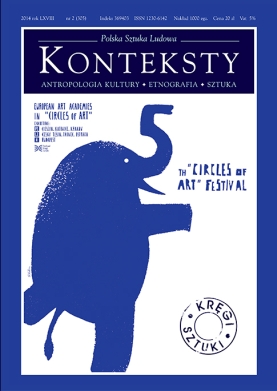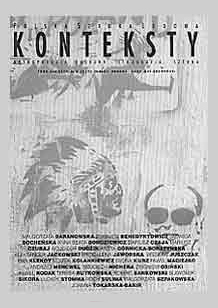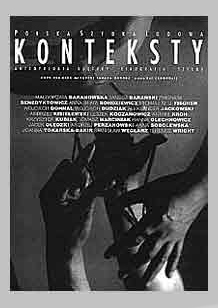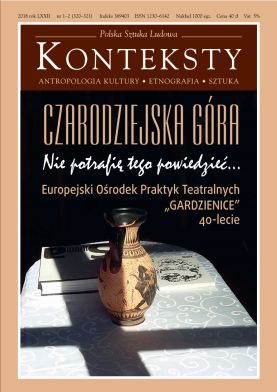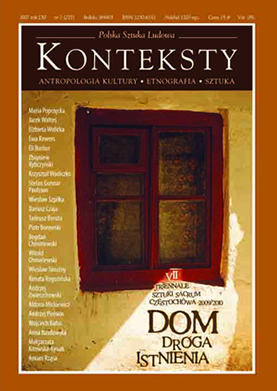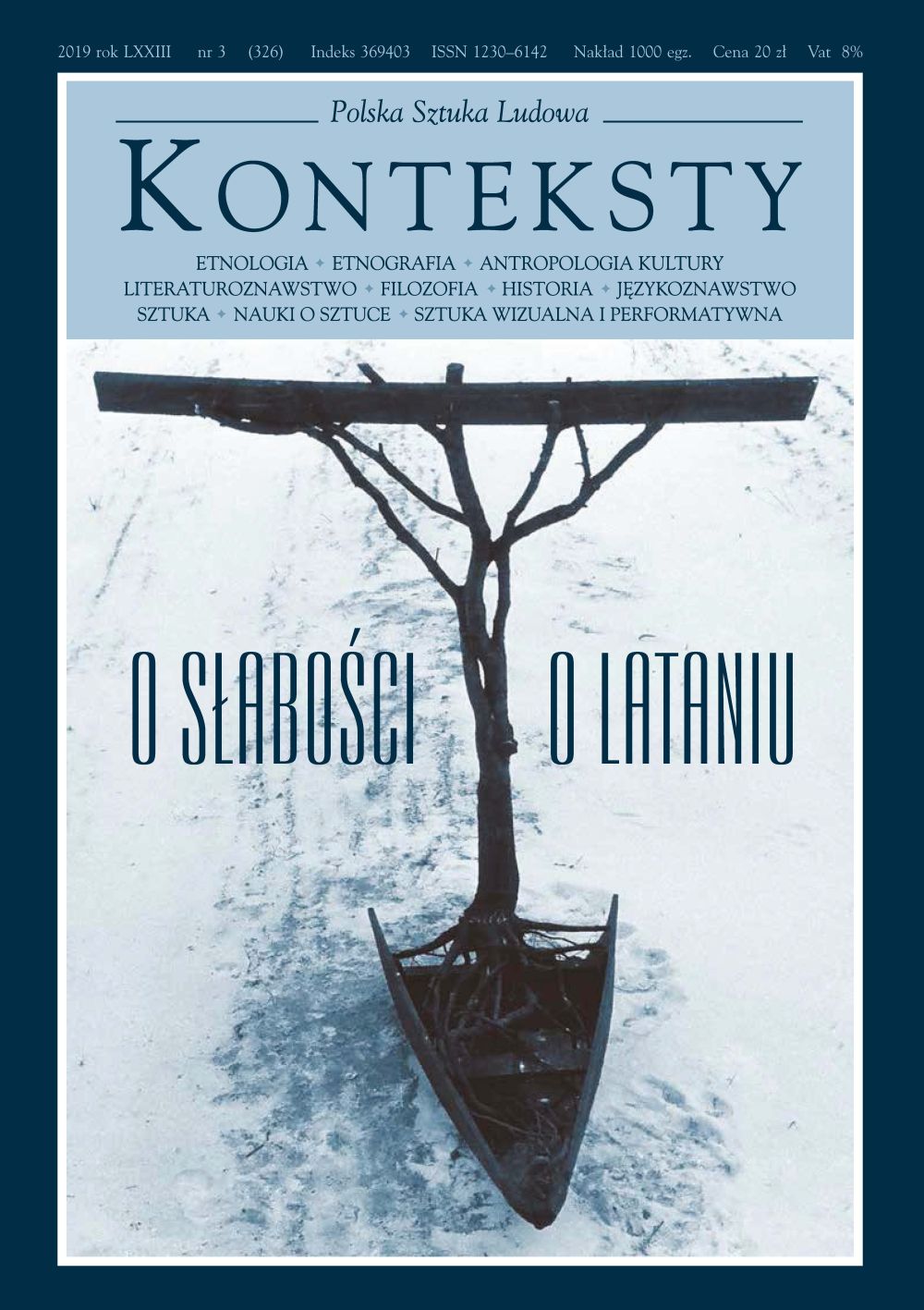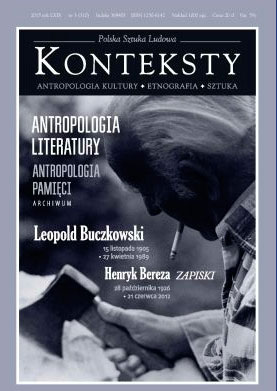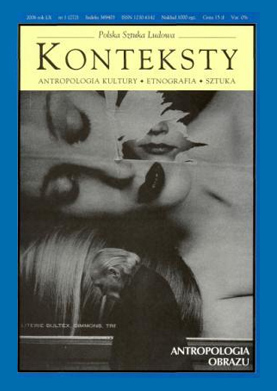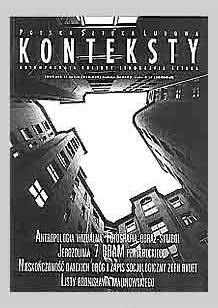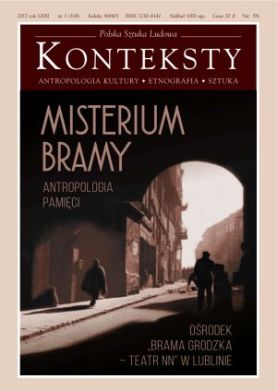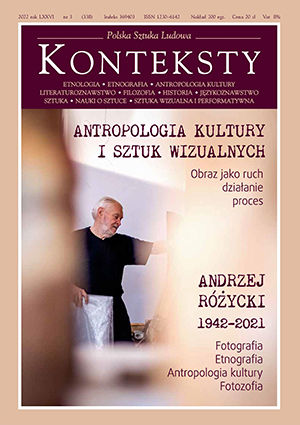Issue 2022/4 (339) - Jan Goślicki / Pandemics in Culture
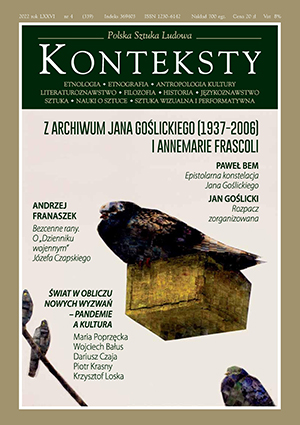
| Jan Goślicki - Epistolary Life | ||
| Annemarie Frascoli | Jan Goślicki or Jan Maurycy Amstisławski  | 3 |
The monographic part of the periodical devoted to the life and works of Jan Goślicki and Annemarie Frascoli is divided into three chapters, each preceded by an introduction by Paweł Bem. The foundation of the first chapter: Jan Goślicki – żywot epistolarny, is composed of Jan Goślicki’s correspondence with eminent representatives of Polish (not exclusively) humanities, selected from Polish and foreign archives. The letters presented in this chapter include those exchanged by Goślicki and Jerzy Giedroyc, Czesław Miłosz, Jerzy Stempowski, Peter Lachmann, and Jan Józef Lipski as well as correspondence addressed by Goślicki to Kazimierz Wyka, Karl Dedecius, Leszek Kołakowski, Wiktor Weintraub, Jan Błoński, Jeanne Hersch, Ludwik Flaszen, Renata Gorczyńska, and Annemarie Frascoli. Epistolographic material was supplemented by complementary texts: a review of a book by Gustaw Herling-Grudziński, commissioned by Jerzy Giedroyc but never presented in “Kultura” (published in Paris), and preserved in the author’s archive, as well as texts by Goślicki’s living correspondents (Lachmann and Gorczyńska), written specially for this issue. In her reminiscences Gorczyńska explains the circumstances of the exchange of letters with Goślicki, while Peter Lachmann addresses his former correspondent in a brief electronic message. Jan Goślicki was an outstanding letter writer and presumably his lifetime achievement consisted of correspondence, which enabled him to contact the most outstanding intellects of twentieth-century Europe. Published fragments of his vast correspondence provide a modest albeit evocative conception of the worldwide constellation of correspondents which he managed to create. The Goślicki archive preserved relatively few examples – he treated the letters he received as rubbish and their best part has not survived. The sole exception was the most copious collection composed of letters from Miłosz, whose majority was preserved. Fortunately, the recipients of Goślicki’s correspondence were much more meticulous, thus making it possible to locate some of the letters addressed to them. The unique entire correspondence with Giedroyc has been preserved thanks to the “Kultura” editor who copied and stored all letters. The presented letters were selected owing to their literary, scientific, and publicistic merits, in other words, their importance as source material – today they serve as their author’s biography. It is a known fact that the correspondents with whom Goślicki maintained longer contacts were numerous and came from different countries. Their letters are also evidence of Goślicki’s reflections about books which he planned to write and which for assorted reasons were never published. Moreover, they remain a valuable document concerning the Polish post-1968 emigration. Chapter two: Goślicki, czyli poza kanonem, is a collection of Goślicki’s texts and translations scattered in books and periodicals, as well as his up to now unpublished essays and translations preserved in his private archive. The material begins with Wprowadzenie, an unpublished typescript envisaged as an introduction to a never written book about the art of writing, a specific pointer for adepts of literature and readers interested in the magic of language. Successive three texts deal with the life and works of the Swiss author Friedrich Glauser, whom Goślicki described as an anti-Swiss Helvetian. To a considerable extent these commentaries serve as a guidebook to the nuances of Swiss culture and literature. Glauser remains unknown in Poland despite Goślicki’s efforts – he translated a number of the Swiss author’s novels. The successive text – an introduction to the Polish edition of Le sang du ciel (issued as: Krew nieba) by Piotr Rawicz, a French novel which in its time enjoyed considerable success in France; in Poland it remained unpublished up to the time it was translated for Wydawnictwo Krakowskie – concerns one of the prime problems broached by Goślicki, i.e. that of literature (im)possible in the wake of the Holocaust. A further fragment deals with André Kamiński, yet another author unknown in Poland, who, in contrast to Rawicz, was Goślicki’s personal acquaintance. Other Goślicki texts and translations are testimony of their author’s meaningful literary canon. They include an unpublished translation of Über das Marionettentheater (On the Marionette Theatre) by Heinrich von Kleist (in the Goślicki archive) as well as an earlier unpublished translation of Kleist in Thun by Robert Walser, a translation of a fragment of poetic prose by Franz Kafka, a collection of quotations from works by Karl Kraus, poems by Abraham Suckewer, the poem: Lamarck by Osip Mandelstam, and texts by the English poetess Anne Beresford. The chapter also includes Goślicki’s introduction to a book by Tomas Venclova about Aleksander Wat, translated by Goślicki, an article on the works of Martin Buber, an introduction to, and a translation of an article by Paul de Man, Goślicki’s master and teacher, described in one of the letters addressed to Jerzy Giedroyc as “one of the best structuralists in the world”, a translation of a paper on the study of foreign languages (after all, Goślicki was a polyglot) read in Solura by Peter Bichsel (born 1935), a Swiss man of letters, teacher, and friend of Max Frisch; the coda of this part of our issue consists of a fragment of the conclusion of Goślicki’s book: Sztuka reklamy, the outcome of a course conducted by him at the School of Commodity Service and Management at the Cracow University of Economics during the first half of the 1990s. Chapter three: Goślicki, czyli rozpacz zorganizowana, contains material pertaining to Goślicki’s appearance at the Piwnica pod Baranami cellar cabaret during the 1990s, upon returning to Poland. His letters to Ludwik Flaszen or Annemarie Frascoli, published in the first chapter, cast light on the backstage aspects (literally and not in so many words) of work pursued by the company headed by Piotr Skrzynecki, who introduced Goślicki as a “poet” or an “intellectual”. The title of Goślicki’s five minute-long Rozpacz zorganizowana (Organised Despair) sketches refers to the wisdom of the Hasidic rabbi Nachman of Bracław, who supposedly maintained that contrary to diabolical depression caused by the spleen despair is a thing of the heart, an important and valuable gift bestowed by the Lord, of which one should not totally divest oneself. In order to avoid a surplus of despair, however, it should be limited to several minutes daily and the remaining time be granted to joy. The chapter in question presents Goślicki‘s translations of the “founding” Nachman parables as well as a letter to an unknown addressee, preserved in the archive and concerning work connected with the Piwnica, including translations of poems by Paul Celan, also used in performances on this Cracow cabaret stage, records of Goślicki’s performances and occasional appearances connected with the Piwnica, previously published in “Dekada Literacka”, and, finally, translations of Celan’s poetry and essays dedicated to the works of Ludwik Flaszen, Goślicki’s long-term friend, in which Goślicki discovered on occasion unexpected but highly convincing affinities by choice with the Paul Celan–Ludwik Flaszen constellation. Collected texts by Jan Goślicki are accompanied by reproductions of corresponding works by his wife, Annemarie Frascoli, a Swiss artist for years co-working with him and author of compositions frequently closely connected with her husband’s literary texts. An excellent example of such husband-and-wife cooperation are reproductions of Frascoli’s illustrations, published in this issue and intended for Goślicki’s translations of parables by Nachman of Bracław and poems by Suckerwer or Paul Celan. A separate section is dedicated to Frascoli’s individual compositions, indirectly associated with texts by Jan Goślicki, although their themes often noticeably refer to historical and philosophical questions broached both by husband and wife. | ||
| Paweł Bem | “I believe in creativity via correspondence”. The Epistolary Constellation of Jan Goślicki | 7 |
| Paweł Bem | “The Sin of Insufficient Clarity”. On Jan Goślicki and His Letters to Jerzy Giedroyc | 11 |
| Jerzy Giedroyc, Jan Goślicki | Letters | 22 |
| Jan Amstisławski | Anti-Herling | 39 |
| Jan Goślicki | Letters to Gustaw Herling-Grudziński | 43 |
| Jan Goślicki, Czesław Miłosz | Letters | 51 |
| Jan Goślicki | Letters to Jeanne Hersch | 73 |
| Jan Goślicki | Letter to Karl Dedecius | 76 |
| Jan Goślicki | Letter to Kazimierz Wyka | 79 |
| Magdalena Chabiera | Perforce Relation Jerzy Stempowski – Jan Goślicki | 82 |
| Jan Goślicki, Jerzy Stempowski | Letters | 85 |
| Jan Goślicki, Leszek Kołakowski | Letters | 91 |
| Jan Goślicki | 103 | |
| Jan Goślicki | Letters to Jan Błoński | 113 |
| Renata Gorczyńska | John Lackland | 121 |
| Jan Goślicki | Letters to Renata Gorczyńska | 123 |
| Jan Goślicki, Jan Józef Lipski | Letters | 129 |
| Jan Goślicki | Letters to Ludwik Flaszen | 132 |
| Peter Lachmann | Mail to a Corpse | 136 |
| Jan Goślicki, Peter Lachmann | Letters | 137 |
| Jan Goślicki | Letters to Annemarie Frascoli | 141 |
| Goślicki, or Beyond the Canon | ||
| Paweł Bem | Introduction to an Introduction. And an End | 147 |
| Jan Goślicki | The Art of Writing | 153 |
| Jan Goślicki | Introduction to Glauser | 158 |
| Jan Goślicki | Matto regiert | 164 |
| Jan Goślicki | Infernal Machine. On ‘Wachtmeister Studer’ | 168 |
| Jan Goślicki | Irony as a Rhetorical Figure in the Wake of the Holocaust. Le sang du ciel / Krew nieba | 172 |
| Jan Goślicki | André Kaminski. A Word about the Author | 176 |
| * | Über das Marionettentheater | 177 |
| Jan Goślicki | The Topic is Dance. Über das Marionettentheater by Heinrich von Kleist | 180 |
| Robert Walser | Kleist in Thun | 184 |
| Franz Kafka | Gesprächsblätter fragments | 188 |
| Karl Kraus | Quotes | 189 |
| Abraham Suckewer | Poetische Werks | 191 |
| Jan Goślicki | Embodiments of the Word. From the Translator of ‘Aleksander Wat: Life and Art of an Iconoclast’ by Tomas Venclova | 193 |
| Osip Mandelsztam | Lamarck | 194 |
| Jan Goślicki | “Biblical” Buber | 195 |
| Jan Goślicki | Between the Apocalypse and Humour | 198 |
| Anne Beresford | Snapshots from an Album Pilgrimage | 199 |
| Jan Goślicki | The de Man Formulae | 201 |
| Peter Bichsel | Alles von mir gelernt | 203 |
| Jan Goślicki | The End | 209 |
| Goślicki, or Organised Despair | ||
| Paweł Bem | Matters of the Heart and Matters of the Spleen | 213 |
| * | Hassidic Parables | 215 |
| Jan Goślicki | Letter to NN | 217 |
| Jan Goślicki | A Word on Organised Despair | 218 |
| Jan Goślicki | Organised Despair | 219 |
| Paul Celan | Poems | 223 |
| Jan Goślicki | Organised Despair 2. Ludovicus Triumphalis: Flaszen Ludwik “Pact” in Italics | 225 |
| Jan Goślicki | Pact ‘97: avec humilité | 229 |
| Jan Goślicki | From “Organized Despair on Vacation” | 235 |
| Jan Goślicki | Speech given on 15.5.96, at a reception held at Hotel Pollera upon the occasion of the 40th anniversary of Piwnica pod Baranami | 237 |
| Andrzej Franaszek | „Invaluable Wounds”. On Dziennik wojenny by Józef Czapski  | 239 |
Dziennik wojenny (Wartime Diary) by Józef Czapski encompasses two years in the author’s life – from the spring of 1942 to the spring of 1944. This was a period when Czapski, released from a Soviet camp and officer of the General Anders Army, worked as chief of the military propaganda-education department, supervised the editing of newspapers and books as well as theatre spectacles, concerts, reportages and documentary films, and was in charge of lectures and courses intended for soldiers. Together with the whole Army he travelled from the Soviet Union, via the Middle East, Palestine, and Egypt all the way to Italy, becoming increasingly aware that contrary to hope he would be unable to return “from Italy to Poland”. In his capacity as one of the officers closest to Anders, Czapski made the acquaintance of Władysław Sikorski and took part not only in the official tasks of the Army command, but also in backstage conflicts and even, to a certain degree, in a conspiracy association whose founder – acting in the name of the best interests of Poland or solely his own – planned to topple the Commander-in-Chief and fantasized about a future Republic spanning from the Baltic to the Black Sea. At the time, similarly as during his entire life, Czapski attempted to oppose Polish nationalism as well as anti-Ukrainian and anti-Jewish stands, to alleviate conflicts, and to seek agreement. Dziennik thus depicts a soldier, an organiser, and even a politician, although it is to a greater degree a portrait of an extremely reserved and reticent artist. Successive pages record a perceptive and rare analysis – possibly the sole in Polish culture – of Czapski’s anguish caused both by the inability to realise his true calling, i.e. that of a painter, and by love for another man. In addition, Dziennik contains a distinct spiritual trail designated by the rhythm of doubt and the struggle waged for the certitude of faith. The author of the presented article attempted to apply all these elements to create a portrait of Józef Czapski not merely as a figure from an encyclopaedia or a dictionary of “great Poles of the twentieth century” but as a bearer of “wounds” which Czapski himself described as “invaluable”. | ||
| Wojciech Bałus | Freedom Square, Pandemics, and Culture  | 264 |
An introduction to the Pandemic and Culture section. The texts were presented on 20 October 2022 in the course of The World in the Face of New Challenges session organised by the Polish Academy of Sciences and Arts in Cracow. An analysis of a photograph showing a temporary COVID-19 vaccination centre in Freedom Square in Brno draws attention to motifs present for long in narrations dealing with pandemics: belief in the supernatural origin of pestilence and the effectiveness of exclusively “spiritual” measures in overcoming it (Pestsäule), modern recognition of an epidemic as a natural phenomenon (inoculations), awareness of the insignificance of worldly possessions in the face of pestilence (an empty automobile in the foreground), and rise of apocalyptic moods. | ||
| Dariusz Czaja | Pandemic and the Apocalypse Virus  | 266 |
For many the appearance of the coronavirus in Europe was tantamount to a fulfilment of the prophecy contained in the Revelation of St. John. Apocalyptic rhetoric frequently recurred in statements made by members of the Church hierarchy and secular publicists. The author of the presented text considers the reason of using the apocalyptic matrix for the purpose of understanding the actual expansion of the coronavirus and proposes abandoning the naive, referential reading of the Revelation of St. John for the sake of an existential approach. The apocalyptic time dimension perceived from this perspective would signify that the Beginning and the End are within every moment and do not create extra-temporal borders. A thus comprehended apocalyptic quality is not a gloomy story about the dangers threatening us (rainfalls of blood, falling stars, and swarming locusts) but the realistic name of a condition in which our fate is resolved constantly. | ||
| Piotr Krasny | “Whoever Looks on Him Will Live”. Works of Religious Art as Visual Cures against the Plague  | 271 |
W epoce nowożytnej rozpowszechnione było przekonanie, że oglądanie świętych wizerunków może uleczyć chorych w trakcie epidemii. Obrazy takie obnoszono więc w procesjach nie tylko w celu ukazania ich tłumom, ale także oczyszczenia powietrza ze śmiercionośnych miazmatów. W XV w. przedstawienia patronów chroniących przez zarazą zaczęto malować na sztandarach, które były lżejsze od obrazów, a zatem łatwiejsze do przenoszenia. Dzieła takie, zamawiane u najwybitniejszych artystów (np. u Guida Reniego), wyobrażały z reguły protektora, orędującego u Boga za miastem, ukazanym w dolnej części malowidła. Zdarzało się też, że takie lecznicze obrazy malowano na ścianach kościołów lub domów, aby były one łatwo dostępne dla jak największej rzeszy wiernych przez całą dobę. Po Soborze Trydenckim zaczęto tłumaczyć, że w przeciwepidemicznych obrazach nie kryje się żadna nadprzyrodzona moc, ale ogrywają one pomocniczą rolę w uratowaniu zakażonych, pobudzając ich do gorliwej modlitwy o uzdrowienia. Szczególną zachętę, a zarazem najlepsze warunki do modlitwy zapewniały całe kościoły, fundowane specjalnie po to, aby chronić i wspierać lud podczas pomoru. Jedną z pierwszych takich budowli zaprojektował i wzniósł w Volders w Tyrolu Hippolytus Guarinonius, lekarz zasłużony w walce z epidemią i autor poczytnej rozprawy prezentującej sposoby takich zmagań. Wyjątkową wartością artystyczną wyróżnia się zaś Karlskirche w Wiedniu, ufundowana przez cesarza Karola VI, który nakazał, aby lud gromadził się w niej codziennie i upraszał zachowanie od moru wszystkich mieszkańców monarchii habsburskiej. Oba kościoły, zbudowane koło masowych grobów ofiar zarazy pełniły też funkcję terapeutyczną, ponieważ pokazały, że epidemie przemijają, a Boże miłosierdzie, objawiane w tych świątyniach trwa nieustannie. Dzieła sztuki wspierające wiernych w zmaganiach z zarazami były rozpowszechnione i szeroko akceptowane w sztuce nowożytnej nawet jeśli sposób ich recepcji i używania przez lud zbliżał się czasem niebezpiecznie do praktyk magicznych lub do bałwochwalstwa. | ||
| Krzysztof Loska | Outbreak Narratives in Feature Films  | 279 |
Adopting Susan Sontag’s suggestion that looking at images of the catastrophe, “one can participate in the fantasy of living through one’s own death and more, the death of cities, the destruction of humanity itself”, author of an essay intends to focus on the ways of depicting the plague, as well as on the variants of the ‘outbreak narrative’ in feature films, in which recurring thematic and fictional motifs can be distinguished that aim to present crisis management mechanisms (state of emergency, quarantine, prohibition of movement, etc.). The author is going to prove that filmmakers like to exploit narrative patterns to draw attention to the dangers of technological development, environmental pollution, and diseases. The ‘outbreak narrative’ shows the deep nature of the transformations taking place in the social world and interpersonal relations. | ||
| Maria Poprzęcka | Art and AIDS  | 284 |
The purpose of the paper is to present the specific character of the HIV/AIDS epidemic, which in the Western countries had a remarkable impact upon artists, intellectuals and members of the show business community. This is why it found a particularly strong and direct echo in literature, dramaturgy, film and visual arts — the latter being the focal point of the paper. Treating Susan Sontag’s essay „AIDS and Its Metaphors”, first published in 1988 (mere few yers after the first appearance of acquired immunodeficiency syndrome), one can trace significant shifts in social attitudes towards AIDS, which is reflected particularly well through arts and culture. In the early stages of the epidemics, the perceived association of the infection with non-normative forms of sexual activity led to degradation and stigmatization of the ill, who were often forced to conceal their immunological status. Multiple factors, such as medical developments, as well as expansion of social toleration of diversity results in the current process of mythologizing the victims, who were often stars of popular culture. One has to notice that these tendencies are predominant mostly in Western countries, where the epidemics has been largely curtailed. The situation is dramatically different in the poor countries of Africa, which first experienced the onset of the virus and which still face vast dangers of its continuous spread. | ||
| Justyna Chmielewska | Compost. About the 17th Istanbul Biennial  | 289 |
This year’s edition of the Istanbul Biennial, held at t time of several global crises (a pandemic, a climate crisis, and a series of economic and political breakdowns), concentrated on organic motifs: composting and fermentation, slow processes of the transformation and regeneration of matter, as well as the co-inhabitation of the Earth by assorted communities – human and non-human. The author takes a closer look at the metaphors around which the Biennial curators organised this year’s exhibitions, and their participation in select works. In their capacity as interpretation instruments such metaphors prove to be useful also within wider contexts by making it possible to capture the profoundly ecological dimension of practices which we often reduce to a social or political key, and which render possible the perception of the joint features of ostensibly distant phenomena. | ||
| Danuta Benedyktowicz | Drawings of a Recluse  | 297 |
In the Aleksander Jackowski editorial archive containing manuscripts, research notes, and photographs immense historical and cultural value belongs to documents associated with non-professional artists. The presented text is dedicated to Edmund Monsiel, whose works were discovered after his death and classified upon the basis of his drawings as a model-like example of a schizophrenic artist; quite possibly, had the drawings been assessed exclusively in the categories of artistic merit the fate of Monsiel’s oeuvre would have followed a different path. | ||



